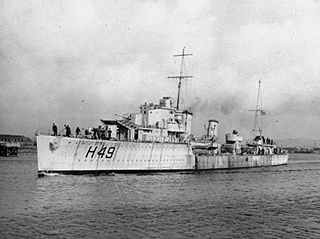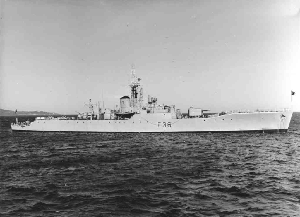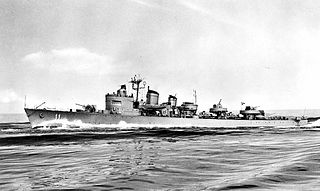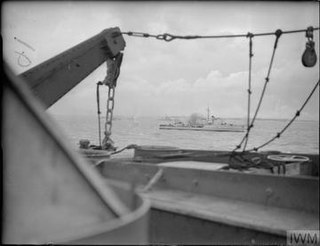
HMS Inconstant was an I-class destroyer built for the Turkish Navy, but was purchased by the Royal Navy in 1939.

The C class was a class of 32 destroyers of the Royal Navy that were launched from 1943 to 1945. The class was built in four flotillas of 8 vessels, the "Ca", "Ch", "Co" and "Cr" groups or sub-classes, ordered as the 11th, 12th, 13th and 14th Emergency Flotillas respectively. The sub-class names are derived from the initial 2 letters of the member ships' names, although the "Ca" class were originally ordered with a heterogeneous mix of traditional destroyer names. A fifth flotilla, the "Ce" or 15th Emergency Flotilla, was planned but were cancelled in favour of the Weapon-class destroyers after only the first two ships had been ordered. The pennant numbers were all altered from "R" superior to "D" superior at the close of World War II; this involved some renumbering to avoid duplications.

The Benson class was a class of destroyers of the U.S. Navy built 1939–1943. The thirty 1,620-ton Benson-class destroyers were built in two groups. The first six were authorized in fiscal year 1938 (FY38) and laid down at Bethlehem Steel, Quincy, Massachusetts, and three naval shipyards. The remaining 24 "repeat Bensons" were authorized in 1940–42 and built at four Bethlehem Steel yards. They were laid down after the first group was commissioned. These plus the "repeat Livermores" were also known at the time as the Bristol class. During World War II the Bensons were usually combined with the Livermores as the Benson-Livermore class; this persisted in references until at least the 1960s. In some references both classes are combined and called the Benson class. The Benson- and Gleaves-class destroyers were the backbone of the pre-war Neutrality Patrols and brought the action to the enemy by participating in every major campaign of the war.

HMS Eastbourne was a Whitby-class or Type 12 anti-submarine frigate of the Royal Navy of the United Kingdom.

HMS Whitby was a Whitby-class or Type 12 anti-submarine frigate of the Royal Navy of the United Kingdom built by Cammell Laird and Co Ltd, Birkenhead. She was launched on 2 July 1954 and commissioned on 10 July 1956.

HMS Dainty was a Daring-class destroyer of the British Royal Navy. Ordered in 1945, she was built by J. Samuel White at their Isle of Wight shipyard, being launched in 1950 and completed in 1953.

The Visby class was a Swedish World War II destroyer class. During the years 1942–1944 four ships, Visby, Sundsvall, Hälsingborg and Kalmar, were built and delivered to the Swedish navy. The ships were a part of Sweden's military buildup during the war. Under this period the ships were used as neutral guards and escort ships. In 1965 the ships were modified and rebuilt as frigates. Two of the ships were decommissioned in 1978 and the last two followed in 1982.

HMS Milne was a M-class destroyer of the Royal Navy which served during World War II. She was equipped as a flotilla leader.

RHS Kanaris (L53) was a Type III Hunt-class destroyer that was originally built for the British Royal Navy as HMS Hatherleigh.

HMS Derwent was a Hunt-class Type III destroyer escort of the Royal Navy. She was built by Vickers-Armstrongs, in Barrow-in-Furness, and served during the Second World War. In March 1943, she was badly damaged while anchored in Tripoli harbour by aircraft and beached to prevent her from sinking. Temporarily repaired and towed to England, further repair work was halted in January 1945, and she was broken up for scrap in 1947.

The Ehrensköld class was the first "modern" class of destroyer built by the Swedish Navy after the First World War. It introduced several new features, mainly heavy armament in three 12 cm guns and the new 53 cm torpedo. The class included two vessels, Ehrensköld and Nordenskjöld, which were both launched in 1926 and entered service in 1927. They patrolled the Baltic Sea until 1963, after which they became target vessels. Nordenskjöld was scrapped in 1964 and Ehrensköld in 1974.

HMS Chivalrous was one of thirty-two C-class destroyers built for the Royal Navy during the Second World War, a member of the eight-ship Ch sub-class. Commissioned in 1946, she was built as a flotilla leader with additional accommodation for staff officers. The ship was loaned to the Pakistani Navy during the late 1950s and was sold for scrap in 1961 after being returned.

The Douro class of destroyers included five ships used by the Portuguese Navy between 1933 and 1967 and two used by the Colombian Navy.

HMS Oakley was a Type II Hunt-class destroyer of the Royal Navy. She was originally to have been named Tickham, however she was renamed after her sister ship Oakley was transferred to Poland and was renamed ORP Kujawiak (L72). She entered service in May 1943, carrying out convoy escort, patrol and anti-shipping attacks for most of the rest of the Second World War. She was adopted by the Civil community of Leighton Buzzard in Bedforshire as part of Warship Week in 1942. In 1957, she was sold to the West German Navy, serving as a training ship for the German Naval Gunnery school until scrapped in 1972.
NRP Dão was a Douro-class destroyer of the Portuguese Navy. The ship was built in Lisbon Shipyard and completed in 1935. She remained in service until 1960, being refitted and re-armed several times and taking place in a coup attempt in 1936.

The Audaz class was a class of nine destroyers built for the Spanish Navy after the Second World War. Construction was slow, with only four completed to the original design from 1953–1956. The remaining five ships completed as anti-submarine escorts with a new armament and sensor fit from 1960 to 1965, while the original four ships were also modified to this standard. Built at Ferrol, they completed in 1946–1950 and were rated as gunboats, and were redesignated as frigates in 1959. The last of the class, Intrepido, was stricken in 1982.
The Pizzaro class was a class of eight escort vessels built for the Spanish Navy in the 1940s. Built at Ferrol, they were completed in 1946–1950 rated as gunboats, and were redesignated as frigates in 1959. They started to be withdrawn from use in 1968, with the last of the class, Vincente Yañez Pinzon, stricken in 1982.

HMS Cottesmore was a Hunt-class destroyer of the British Royal Navy. The ship was built by the Scottish shipbuilder Yarrow at their Scotstoun, Glasgow shipyard in 1939–1940, being launched on 5 September 1940 and commissioning on 29 December that year.

The Trad class was a class of nine torpedo boats built for the Royal Thai Navy in the 1930s by the Italian shipbuilder Cantieri Riuniti dell'Adriatico. They entered service between 1935 and 1938. Two of the ships were sunk (and a third badly damaged by French warships at the Battle of Ko Chang in 1941, but the remaining seven ships had long careers, remaining in service until the 1970s.

HMS Serapis was an S-class destroyer of the British Royal Navy. The ship was built by Scotts Shipbuilding and Engineering Company from 1941 to 1943, and was launched on 25 March 1943 and completed on 25 December 1943.


















